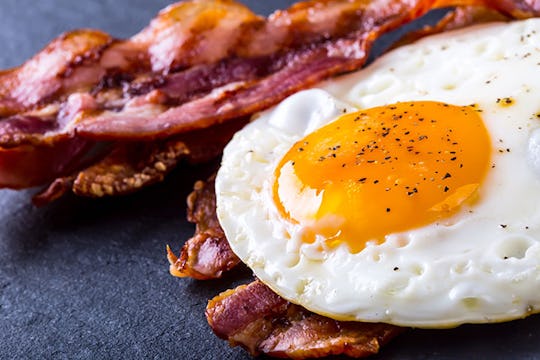“Breakfast is the most important meal of the day. Eat as soon as you wake up to break the fast and set yourself up for healthy eating patterns.“
“Don’t skip meals, your body will think it’s starving and your metabolism will suffer.”
“To keep your metabolism revving, you should eat a mini meal every three hours.”
Most of us have spent the last 20 to 30 years believing these statements to be true. But what if I told you all of these common suppositions might be wrong? Or at least, might not be entirely right?
The modern approach to meal consumption actually stands in stark contrast to more historical standards. This isn’t necessarily a bad thing, but the reality is, we just don’t know for sure.
While modern standards say we should eat three meals a day with snacks between meals, historically, this hasn’t been the norm. Light, ongoing grazing and a single, larger meal is actually more representative of the makeup of historical meal timing.
So why, then, are we so convinced that skipping meals or failing to eat breakfast is “bad” for health and metabolism?
The easy answer is, “Well, research says so,” but that’s only sort of true. The field of nutritional research is still relatively new, and most studies leading to the commonly held beliefs that you shouldn’t skip meals or deny yourself breakfast don’t account for every contributing variable.
For instance, a large-scale epidemiological study that draws the correlation between skipping breakfast and weight gain may not consider factors such as high-stress jobs or the consumption of highly processed foods as co-factors to skipping breakfast.
Plus, common sense flies in the face of claims that skipping meals always negatively impacts metabolism. Just look around – the leanest of individuals are typically calorie restrictive – they control how much they eat, sometimes skipping meals to do so.
As a society, we could certainly benefit from a little more self-control in the kitchen, and if diets are hard to maintain, maybe a well-employed fasting plan could kill two birds with one stone: providing calorie restriction without the overwhelming maintenance of a long-term diet.
That’s why the recent and growing research on the impact and benefits of intermittent fasting is so interesting. And for some people, it could be a real game changer.
What Is Intermittent Fasting?
First, I want to be very clear that intermittent fasting (IF) isn’t even remotely the same thing as anorexia.
Specifically, intermittent fasting is, by nature, intermittent. In other words, it’s done for brief, controlled periods of time. Some of the best examples of intermittent fasting are those associated with religious practices.
For instance, the four-week period of Ramadan during which practicing Muslims don’t eat or drink from sunrise to sunset. They’re welcome to eat during the night, and some even eat to excess, but during the day, an intermittent fast is in effect.
Anorexia, by contrast, is sustained and extreme calorie restriction with the sole intent of fast and extreme fat loss.
3 Types of Intermittent Fasting
 As in all nutrition-related subjects, there are different approaches to IF, none of which have been proclaimed the “outright winner” for fasting benefits.
As in all nutrition-related subjects, there are different approaches to IF, none of which have been proclaimed the “outright winner” for fasting benefits.
This is in part because more research needs to be done, but also because everyone responds differently to nutritional interventions. In other words, outcomes can vary widely based on age, sex, activity level, underlying illnesses and weight.
Generally speaking, the most common approaches are:
1. Full Day Fasting.
Just like it sounds, a full day fast is when a person abstains from eating for a full 24 hours. Some IF plans suggest two full day fasts per week. The remaining five days may or may not follow a calorie-controlled plan.
2. Alternate Day Fasting.
Again, just like it sounds, it’s a day on/day off approach to fasting, where you alternate between fasting and non-fasting days. Usually participants are free to eat whatever they’d like on non-fasting days.
3. Partial Day Fasting.
Partial day fasting has many different approaches regarding when to eat, but what remains the same between programs is that eating is confined each day to an “eating window” – a timeframe that ranges from four hours up to 12 hours.
In other words, fasting takes place daily, but not for a full 24-hour period. Generally speaking, participants are free to eat what they’d like during their “eating window.”
What the Science Says About IF
The research on intermittent fasting is overwhelmingly positive, and not just from a fat loss perspective. A few recent studies have found IF could help:
â Reduce risk of coronary artery disease and diabetes, as well as employ significant, positive changes to blood cholesterol in healthy and pre-diabetic populations.
â Improve markers of longevity that could contribute to a longer lifespan.
â Benefit children with severe epilepsy, reducing seizures beyond the reductions seen using a ketogenic diet alone.
â Override the harmful effects of a high fat diet by preventing obesity and liver disease.
â Improve brain health and help stave off Alzheimer’s Disease.
â Protect cells, slow tumor growth and reduce side effects of chemotherapy treatment in cancer patients.
In other words, IF is pretty amazing. Researchers are still trying to find out why it’s so amazing, but they’re starting to hone in on a few contributing factors.
For instance, a 2015 study performed at the Yale School of Medicine determined that fasting stimulates the release of the compound beta-hydroxybutyrate (BHB).
BHB directly inhibits the inflammasome protein complex, which drives the inflammatory response in disorders including autoimmune diseases, Type 2 diabetes, Alzheimer’s disease, atherosclerosis and autoinflammatory disorders.
In other words, inflammation is a known body-wrecker, and fasting can help prevent the inflammatory response and its associated diseases.
Just be aware that many of the studies performed to date have been on mice and other animals. There have been fewer human studies, so definitive benefits for a human population are less clear.
Doing Intermittent Fasting Right
There are a few things I want to stress about trying an intermittent fasting diet:
1. Know Thyself and Know Thy Challenges.
Intermittent fasting requires control and restriction during fasting periods. If you are prone to disordered eating or eating disorders, IF could act as a trigger for unhealthy behaviors.
Be very careful about trying IF if you think you might use it as an excuse for ongoing or overly restrictive calorie consumption.
2. Keep Training.
The IF studies performed on humans in relation to body composition, muscle mass and athletic performance indicate that intermittent fasting produces the best results when done in conjunction with strength training.
You’re more likely to reduce body fat percentage and maintain or improve muscle mass when you exercise and fast together (although not necessarily on the same days).
3. Eat Well When You’re Not Fasting.
One of the big challenges of a fasting diet is the inclination to over-consume during non-fasting periods. While you don’t necessarily need to count calories or restrict food intake when you’re not fasting, you should prioritize eating healthy, whole foods.
If you counteract your fast with a day of overzealous bingeing on highly processed sugars, you may not see the changes or benefits associated with intermittent fasting.
4. Ease Your Way In.
Intermittent fasting, ultimately, is a lifestyle change. But there’s no reason you can’t give it a test run to see if it’s an approach you’re comfortable with.
Try a single, 24-hour fast to see how it feels, or follow a week of partial day fasting with an 8-hour eating window between 11am and 7pm or 12pm and 8pm. If you find the experience tolerable, consider following an ongoing plan.




)





